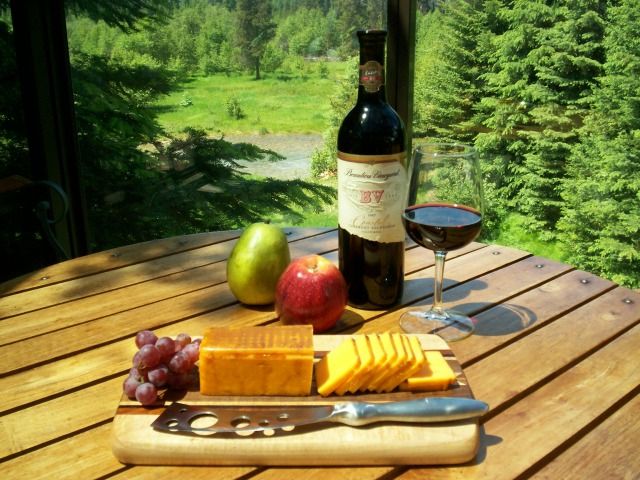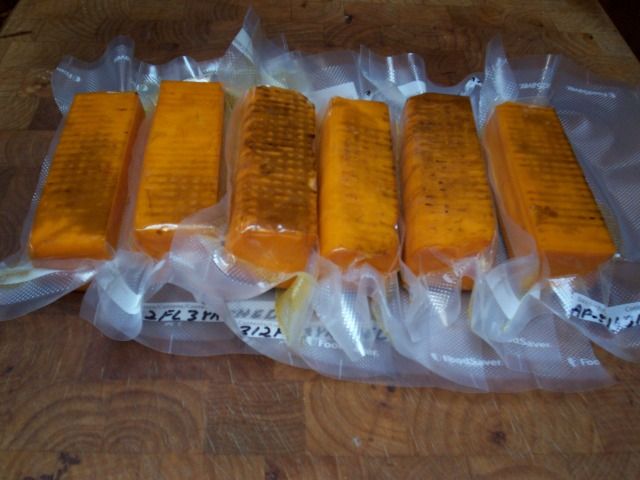
A piece and slices of three year old apple smoked Cheddar
Mr.T’s Smoked Cheese From Go to Show
Those of us who smoke cheese enjoy that little something extra. Smoking cheese is fun and easy to do. Hard cheeses are the easiest and with the proper equipment soft cheeses can add that something spectacular to any meal.
While going to the extra effort to smoke that favorite cheese. Why not add another dimension and age your own cheese and save some really big bucks at the same time. The youngest cheese that I smoke is a minimum of two years old, the oldest and best cheese I have ever eaten is my 12 year old hickory smoked Limburger.
There is a ton of controversy when it comes to aging, smoking and how to preserve cheese. The following are the techniques that I have used for many years; you can glean what you want.
FAQ’s
Question: Can I age store bought cheese?
Answer: Yes, I normally will buy cheese in the cryovac package, 2 to 5 Lbs. the larger the better. The waxed cheeses will age even better.
Question: Will it age in the package?
Answer: Yes it will. Make sure there are no leaks that would allow liquids to escape and contaminates to enter. Cheese will never stop aging. Left long enough, mild cheddar will turn into extra sharp.
Question: At what temperature should I store the cheese?
Answer: Store hard cheeses at temperatures between 70° & 35°. I keep my hard cheeses at minimum of 45°. The closer to 70° the faster it will age. Softer cheeses should be stored in the cooler range of 50° to 35°.
Question: How long can I age my cheese?
Answer: I don’t know of any limits in time. The longest I have aged a cheese is the 14-year-old Limburger. I have read that some have aged Cheddar for 25 years and more.
Over 70 Lbs. Aging Cheese - Average age, 4 years

Question: How much should I smoke?
Answer: Smoke according to the size of the block. I smoke cheese as we need it. At this time it is usually 3 to 4 years old. Cut your blocks into sections approximately the size of a quarter pound stick of butter for better smoke penetration.
Question: At what temperatures should I smoke?
Answer: Answer: A cold smoke will be needed. The definition of a cold smoke is 90° or less. Consider that cheese will begin to change its texture at 80° therefore I will pull mine from the smoker if it hits 70°to 75° then, if needed continue when the elements are cooler continuing the time from when it was pulled from smoker. You can take the cheese on up to the melting point if you like and it may still be desirable to your taste.
Question: How long should I smoke the cheese?
Answer: I usually will smoke the hard cheeses for two hours depending on the density of the smoke and type of wood used. The harder the cheese the more dense smoke it can take. Monitor your smoke as a lighter smoke will infuse a more desirable flavor than a heavy dense smoke will. Cream or blues will take a much shorter smoking time than the harder cheeses. Softer cheeses can be done in around ½ hour. It really depends on your taste.
Question: What woods should I use?
Answer: I use hickory on most but, apple, cherry and alder among others also work very well.
Question: Okay it’s smoked. Now what?
Answer: Place in a zip type bag leaving a small opening to keep condensation from forming and allow it to set on a rack at room temperature for a day. If it is going to be consumed soon, wrap in a cling type wrap and put in fridge or store at previously discussed temperatures. Depending on the type of cheese, if it is going to be kept for a few months, coat it with olive or vegetable oil and place on a rack inside a container and refrigerate. A damp paper towel may be kept in the container to provide added moisture. After slicing some for use reapply oil or reapply every two weeks. The oil will keep mold from forming on the outside. If I am going to to age the cheese further, I will wax the cheese and store as usual.
Question: What cheeses can be waxed.
Answer: Only the hard cheeses should be waxed. Cheddar, Swiss, Colby ect, ect. The less moisture you have in your cheese the better for waxing.
Question: Can I use paraffin to wax cheese?
Answer: No. Paraffin is not pliable and will crack and break in time allowing contaminates in and molds to form. Use only wax designated as cheese wax. It will remain pliable and allow your cheese to breathe which aids in aging. It also will take a much higher heat when melting.
Question: At what temperature should I heat the wax?
Answer: To prevent mold, heat wax to 225°- 240°. Apply three coats by dipping or brushing the wax on. To prevent melting the first coat of wax, apply the additional coats at a lower temp, 160°.
Question: Where can I get Cheese wax?
Answer: Cheese making suppliers will have it or it may be purchased on line.
Waxed Cheese

Smoked 3 year old Cheddar

Question: How is cheese properly served?
Answer: Number one rule: Do not eat cheese cold or straight from the refrigerator. The cold temperature hinders the natural flavors and fragrance of the cheese. The aromatic and complex flavors of cheese don't really begin to appear until the cheese is at room temperature.
Cheese is composed largely of fat. Since fat means flavor, the goal is to amplify it as much as possible. When fat molecules are cold, they contract, when they warm, they relax, allowing a greater perception of flavor.
Pull your cheese out of the refrigerator at least an hour to a hour and a half before serving. To keep your cheese from drying out, never unwrap your cheese when you bring it out of the refrigerator. If serving waxed cheese at room temperature, wait until ready to serve before removing wax or if wrapped, unwrapping.
Be careful, though, especially in the summer months, if you warm up the cheese too much, it'll start to sweat and melt in unappetizing ways. Try to keep it at or around 72°.
To cut any cheese properly—hard or soft —use a good chef's knife or a good all-purpose utility knife. To cut very soft, cheese such as chevre cleanly, use a length of stretched dental floss.
Serving cheese after the main course, prior to or in place of dessert, adds an elegant touch to casual dinners. If served before dinner, with cocktails, remember that cheeses can be filling. Serve in limited quantities and variety.
If serving more than one type of cheese, provide separate knives for each cheese. Do not overcrowd the serving tray, as guest will need room to slice the cheeses.
Question: What do I do if I find mold on my cheese?
Answer: The mold on hard cheeses may be washed with a scrub brush or cut away and re-waxed or oiled. Cut away the mold on soft cheeses and re-wrap.
Question: Can I freeze my smoked or any other cheese?
Answer: It's my opinion that the quality of the cheese is seriously compromised when frozen.
Question: Why does my cheese taste bitter right out of the smoker?
Answer:
It could be as simple as applying too much smoke. It's imperative that you monitor the color and density of your smoke as there are many outside influences that can change both. Take the time that others smoke with a grain of salt, use it possibly as a guide but, not knowing the color and density of their smoke, their info is mostly useless. And they may have a bitter taste out of the smoker themselves.
Remember, regardless the smoke generator you are using, the whiter the smoke, the more unforgiving it is as shorter smoking times are required.
Creosote = Bitter Your smoke is depositing too much creosote onto the cheese. Suggest using a different smoke delivery system such as the ones pictured below. Using an smoke generator inside a cast-iron stove which is used as a heat sink and collects most of the creosote. The smoke then travels through a 10ft section of 3 inch stove pipe to the product chamber. Other smoke delivery systems can be used but will not be discussed on this forum.
An attempt was made in the following thread to demonstrate how to significantly prevent a bitter taste on a product from occurring. You will notice a great difference between placing a smoke generator inside the product chamber/smoker and placing it in an external firebox and piping the smoke to the chamber. Piping the smoke to a chamber produces a much cleaner smoke. The longer the run from the firebox to the chamber, the cleaner the smoke will be, meaning less creosote deposits. AMNPS & Smoke Daddy Myths?
Any Questions. Please ask.
T